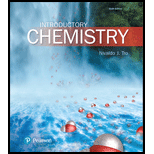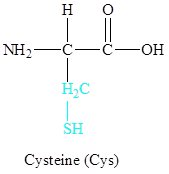
Modified Mastering Chemistry with Pearson eText -- Standalone Access Card -- for Introductory Chemistry (6th Edition)
6th Edition
ISBN: 9780134565620
Author: Nivaldo J. Tro
Publisher: PEARSON
expand_more
expand_more
format_list_bulleted
Concept explainers
Question
Chapter 19, Problem 65E
Interpretation Introduction
Interpretation:
The described structure must be determined for a type of protein folding (primary, secondary, tertiary or quaternary).
Concept introduction:
A cysteine is one of the common amino acids. The structure of cysteine includes a carboxyl group, an NH2 (

Expert Solution & Answer
Want to see the full answer?
Check out a sample textbook solution
Students have asked these similar questions
Steps and explanations please.
Steps on how to solve. Thank you!
3. Name this ether correctly.
H₁C
H3C
CH3
CH3
4. Show the best way to make the ether in #3 by a
Williamson Ether Synthesis.
Start from an alcohol or phenol.
5. Draw the structure of an example of a sulfide.
Chapter 19 Solutions
Modified Mastering Chemistry with Pearson eText -- Standalone Access Card -- for Introductory Chemistry (6th Edition)
Ch. 19 - Prob. 1SAQCh. 19 - Prob. 2SAQCh. 19 - Which compound is an amino acid?Ch. 19 - Q4. The sequence of amino acids in a protein chain...Ch. 19 - Prob. 5SAQCh. 19 - Prob. 6SAQCh. 19 - Prob. 7SAQCh. 19 - Prob. 8SAQCh. 19 - Prob. 9SAQCh. 19 - Q10. How many nucleotides are required to code for...
Ch. 19 - Prob. 1ECh. 19 - Prob. 2ECh. 19 - Prob. 3ECh. 19 - Prob. 4ECh. 19 - Prob. 5ECh. 19 - Prob. 6ECh. 19 - Prob. 7ECh. 19 - Prob. 8ECh. 19 - Prob. 9ECh. 19 - Prob. 10ECh. 19 - Prob. 11ECh. 19 - Prob. 12ECh. 19 - Prob. 13ECh. 19 - Prob. 14ECh. 19 - Prob. 15ECh. 19 - Prob. 16ECh. 19 - What are steroids? What are some of the functions...Ch. 19 - Prob. 18ECh. 19 - What are the main functions of proteins within...Ch. 19 - Prob. 20ECh. 19 - Prob. 21ECh. 19 - Prob. 22ECh. 19 - Prob. 23ECh. 19 - Prob. 24ECh. 19 - Prob. 25ECh. 19 - Prob. 26ECh. 19 - Prob. 27ECh. 19 - Prob. 28ECh. 19 - Prob. 29ECh. 19 - Prob. 30ECh. 19 - Prob. 31ECh. 19 - Prob. 32ECh. 19 - Prob. 33ECh. 19 - Prob. 34ECh. 19 - Prob. 35ECh. 19 - Prob. 36ECh. 19 - What is a gene?Ch. 19 - Prob. 38ECh. 19 - Prob. 39ECh. 19 - Do most cells in the human body contain genes for...Ch. 19 - Prob. 41ECh. 19 - Prob. 42ECh. 19 - Prob. 43ECh. 19 - 44. Describe the process of protein synthesis.
Ch. 19 - Prob. 45ECh. 19 - Prob. 46ECh. 19 - Prob. 47ECh. 19 - Prob. 48ECh. 19 - Prob. 49ECh. 19 - Prob. 50ECh. 19 - Prob. 51ECh. 19 - Prob. 52ECh. 19 - Prob. 53ECh. 19 - 54. Determine whether each molecule is a lipid. If...Ch. 19 - 55. Sketch the block diagram for a triglyceride.
Ch. 19 - 56. Sketch the block diagram for a phospholipid....Ch. 19 - 57. Draw the structure of the triglyceride that...Ch. 19 - Prob. 58ECh. 19 - Prob. 59ECh. 19 - Prob. 60ECh. 19 - Prob. 61ECh. 19 - Prob. 62ECh. 19 - Prob. 63ECh. 19 - Prob. 64ECh. 19 - Prob. 65ECh. 19 - Prob. 66ECh. 19 - Prob. 67ECh. 19 - A particular protein is composed of two individual...Ch. 19 - Prob. 69ECh. 19 - Prob. 70ECh. 19 - Prob. 71ECh. 19 - Prob. 72ECh. 19 - Prob. 73ECh. 19 - Prob. 74ECh. 19 - Prob. 75ECh. 19 - Prob. 76ECh. 19 - Prob. 77ECh. 19 - Prob. 78ECh. 19 - 79. Match each term with its correct meaning.
...Ch. 19 - Prob. 80ECh. 19 - The amino acid glycine has this condensed...Ch. 19 - Prob. 82ECh. 19 - Since amino acids are asymmetrical, a peptide with...Ch. 19 - Prob. 84ECh. 19 - Prob. 85ECh. 19 - Prob. 86ECh. 19 - Prob. 87ECh. 19 - Prob. 88ECh. 19 - Prob. 89ECh. 19 - 90. A solution is made by dissolving 28.65 mg of a...Ch. 19 - Prob. 91ECh. 19 - 92. Sickle-cell anemia is caused by a genetic...Ch. 19 - Prob. 93QGWCh. 19 - Prob. 94QGWCh. 19 - Discuss these questions with the group and record...
Knowledge Booster
Learn more about
Need a deep-dive on the concept behind this application? Look no further. Learn more about this topic, chemistry and related others by exploring similar questions and additional content below.Similar questions
- 1. Which one(s) of these can be oxidized with CrO3 ? (could be more than one) a) triphenylmethanol b) 2-pentanol c) Ethyl alcohol d) CH3 2. Write in all the product(s) of this reaction. Label them as "major" or "minor". 2-methyl-2-hexanol H2SO4, heatarrow_forward3) Determine if the pairs are constitutional isomers, enantiomers, diastereomers, or mesocompounds. (4 points)arrow_forwardIn the decomposition reaction in solution B → C, only species C absorbs UV radiation, but neither B nor the solvent absorbs. If we call At the absorbance measured at any time, A0 the absorbance at the beginning of the reaction, and A∞ the absorbance at the end of the reaction, which of the expressions is valid? We assume that Beer's law is fulfilled.arrow_forward
- > You are trying to decide if there is a single reagent you can add that will make the following synthesis possible without any other major side products: 1. ☑ CI 2. H3O+ O Draw the missing reagent X you think will make this synthesis work in the drawing area below. If there is no reagent that will make your desired product in good yield or without complications, just check the box under the drawing area and leave it blank. Click and drag to start drawing a structure. Explanation Check ? DO 18 Ar B © 2025 McGraw Hill LLC. All Rights Reserved. Terms of Use | Privacy Center | Accessibilityarrow_forwardDon't use ai to answer I will report you answerarrow_forwardConsider a solution of 0.00304 moles of 4-nitrobenzoic acid (pKa = 3.442) dissolved in 25 mL water and titrated with 0.0991 M NaOH. Calculate the pH at the equivalence pointarrow_forward
- What is the name of the following compound? SiMe3arrow_forwardK Draw the starting structure that would lead to the major product shown under the provided conditions. Drawing 1. NaNH2 2. PhCH2Br 4 57°F Sunny Q Searcharrow_forward7 Draw the starting alkyl bromide that would produce this alkyne under these conditions. F Drawing 1. NaNH2, A 2. H3O+ £ 4 Temps to rise Tomorrow Q Search H2arrow_forward
arrow_back_ios
SEE MORE QUESTIONS
arrow_forward_ios
Recommended textbooks for you
 Introduction to General, Organic and BiochemistryChemistryISBN:9781285869759Author:Frederick A. Bettelheim, William H. Brown, Mary K. Campbell, Shawn O. Farrell, Omar TorresPublisher:Cengage Learning
Introduction to General, Organic and BiochemistryChemistryISBN:9781285869759Author:Frederick A. Bettelheim, William H. Brown, Mary K. Campbell, Shawn O. Farrell, Omar TorresPublisher:Cengage Learning Chemistry & Chemical ReactivityChemistryISBN:9781133949640Author:John C. Kotz, Paul M. Treichel, John Townsend, David TreichelPublisher:Cengage Learning
Chemistry & Chemical ReactivityChemistryISBN:9781133949640Author:John C. Kotz, Paul M. Treichel, John Townsend, David TreichelPublisher:Cengage Learning Chemistry for Today: General, Organic, and Bioche...ChemistryISBN:9781305960060Author:Spencer L. Seager, Michael R. Slabaugh, Maren S. HansenPublisher:Cengage Learning
Chemistry for Today: General, Organic, and Bioche...ChemistryISBN:9781305960060Author:Spencer L. Seager, Michael R. Slabaugh, Maren S. HansenPublisher:Cengage Learning General, Organic, and Biological ChemistryChemistryISBN:9781285853918Author:H. Stephen StokerPublisher:Cengage Learning
General, Organic, and Biological ChemistryChemistryISBN:9781285853918Author:H. Stephen StokerPublisher:Cengage Learning Organic And Biological ChemistryChemistryISBN:9781305081079Author:STOKER, H. Stephen (howard Stephen)Publisher:Cengage Learning,
Organic And Biological ChemistryChemistryISBN:9781305081079Author:STOKER, H. Stephen (howard Stephen)Publisher:Cengage Learning, World of Chemistry, 3rd editionChemistryISBN:9781133109655Author:Steven S. Zumdahl, Susan L. Zumdahl, Donald J. DeCostePublisher:Brooks / Cole / Cengage Learning
World of Chemistry, 3rd editionChemistryISBN:9781133109655Author:Steven S. Zumdahl, Susan L. Zumdahl, Donald J. DeCostePublisher:Brooks / Cole / Cengage Learning

Introduction to General, Organic and Biochemistry
Chemistry
ISBN:9781285869759
Author:Frederick A. Bettelheim, William H. Brown, Mary K. Campbell, Shawn O. Farrell, Omar Torres
Publisher:Cengage Learning

Chemistry & Chemical Reactivity
Chemistry
ISBN:9781133949640
Author:John C. Kotz, Paul M. Treichel, John Townsend, David Treichel
Publisher:Cengage Learning

Chemistry for Today: General, Organic, and Bioche...
Chemistry
ISBN:9781305960060
Author:Spencer L. Seager, Michael R. Slabaugh, Maren S. Hansen
Publisher:Cengage Learning

General, Organic, and Biological Chemistry
Chemistry
ISBN:9781285853918
Author:H. Stephen Stoker
Publisher:Cengage Learning

Organic And Biological Chemistry
Chemistry
ISBN:9781305081079
Author:STOKER, H. Stephen (howard Stephen)
Publisher:Cengage Learning,

World of Chemistry, 3rd edition
Chemistry
ISBN:9781133109655
Author:Steven S. Zumdahl, Susan L. Zumdahl, Donald J. DeCoste
Publisher:Brooks / Cole / Cengage Learning
Biomolecules - Protein - Amino acids; Author: Tutorials Point (India) Ltd.;https://www.youtube.com/watch?v=ySNVPDHJ0ek;License: Standard YouTube License, CC-BY